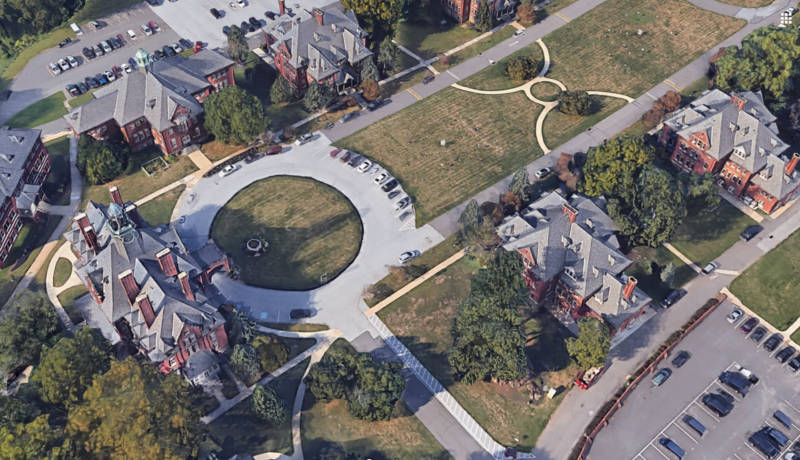F
or years, counties throughout the Bay Area and California have been sending teenage boys in trouble with the law to a Philadelphia-area institution that is now the target of allegations of widespread physical abuse.
Those placements continued in some cases despite the findings of an unannounced June 2016 inspection by California officials that staff at the Glen Mills Schools routinely punished boys for behavior such as biting their lips, flinching or shifting their eyes while talking to counselors.
The punishment sometimes took the form of physically restraining students or forcing them to sit for long periods in violation of regulations that limit such techniques to situations where the teens are “assaultive” or endangering themselves or others.
Those findings were summarized in a brief report on the inspection visit to Glen Mills, considered the nation’s oldest “reform school” for male youth.
“Under no circumstances shall physical restraints be used as disciplinary action,” MaryJo Tobola, a California Department of Social Services official, wrote in the June 17, 2016, summary.
By the department’s definition, permissible restraints for an assaultive juvenile or one posing a danger could range from staff members positioning themselves to limit a teen’s movement to use of “mechanical devices” to placing a juvenile in a seclusion room.
But “physical restraints” at Glen Mills reportedly went far beyond such methods.
In February, a Philadelphia Inquirer investigation reported allegations of beatings and other extreme physical abuse by some Glen Mills staff members and efforts by the school’s officials to cover them up.
“We have repeatedly heard from numerous youth that Glen Mills staff would use the term ‘physical restraint’ to include punching, choking, body slamming, head butting and painfully limiting the movement of youth from ‘violations,’ including not ‘shutting up’ and not tying shoes,” said Nadia Mozaffar, a staff attorney at the Philadelphia-based Juvenile Law Center, among several groups that have filed lawsuits against the institution. “At Glen Mills, ‘physical restraint’ was a euphemism for physical assault.”
Pennsylvania regulators have revoked the school’s permits, and juveniles housed at the institution have been pulled out and sent elsewhere.
“That’s the horrific point of all of this — that everyone anecdotally heard these stories. It was so prevalent,” said Maura McInerney, legal director of the Philadelphia-based Education Law Center, which also represents Glen Mills plaintiffs. “There should have been alarm bells going off for everyone.”

California Used Glen Mills For Decades
More than a dozen counties in California, including several in the Bay Area, have sent scores of boys to the school, according to interviews with local probation officials and a review of publicly available California Department of Social Services records.
A state report that identified “deficiencies” at Glen Mills in 2016 said that supervisors there told inspectors they would make it clear to their staff that the abusive behavior needed to stop.
“If not corrected, these violations will have direct and immediate risk to the health, safety or personal rights of youth in care,” Tobola of the CDSS wrote.
But weeks after the inspection, the agency extended its certification of Glen Mills for another year. The Department of Social Services went on to extend the certification over the next several years as well.
Michael Weston, a CDSS spokesman, said Glen Mills eventually completed a plan of correction by training its staff on the appropriate use of restraints.
Daniel Macallair, executive director of the San Francisco-based Center on Juvenile and Criminal Justice, says California regulators may have been reluctant to hold Glen Mills accountable.
In part, he said, that’s because of the limited number of placement options the state has. But it’s also because abuses are not uncommon.
“There’s some reluctance to push too hard, to open too many doors or look under too many rugs,” Macallair said. “If we were to pull the curtain back all the way, we’d have to shut the entire system down, because these are the kinds of things that happen in these places.”
In February, the Inquirer’s story pulled the curtain back on numerous incidents in which teens sent to Glen Mills were battered and brutalized by the school’s staff.
The episodes included cases in which staff injured two boys at the school so severely they needed staples to close scalp wounds. In another case, the Inquirer said, a teen required stitches in his back after a staff member pushed him through a plate glass window. Another reported episode involved a counselor stepping on a boy’s face, breaking his jaw.
The Inquirer story led to calls for the school to close and raised questions over whether Pennsylvania regulators had ignored abuse at the school.
In March 16 juveniles from California were among the hundreds pulled out of the school after it lost its Pennsylvania licenses, according to Ali Fogarty, a spokeswoman for the Pennsylvania Department of Human Services.
Last Friday, Weston told KQED that state social services officials have launched an investigation into the circumstances surrounding Glen Mills.
The outcome of that probe could lead California regulators to revoke the school’s license to take in kids from the state.
Santa Cruz Abuse Case
One of the boys profiled in the Philadelphia Inquirer series was Nathan Thomas, who was 16 when he was sent to Glen Mills from Santa Cruz in 2011.
Thomas told the paper that counselors liked to bash students’ heads into the door of a refrigerator.
He said one day a counselor overhead him talking with another boy about abuse at the facility. The staff member took him to the refrigerator, which was dented by the heads of his fellow students. Thomas said the staff member slammed his head into the door, choked him and spit in his face. A second counselor slapped him, Thomas said.
Jason Hoppin, a Santa Cruz County spokesman, said he could not comment on specific abuse allegations. But he added that probation staff occasionally hear complaints of abuse during state-mandated monthly visits to facilities outside California.
In those cases, Santa Cruz officials refer the complaints to child protective agencies in the jurisdictions where the facilities are located, Hoppin said.
“We have given a client a code word to use to relay any concerns he may have had about his situation,” Hoppin said. “We hate to hear about this kind of stuff, and we act quickly and thoroughly when we do hear complaints like that.”
The county has sent eight juvenile offenders to Glen Mills in the last decade, Hoppin said. He added that the county has a limited number of beds in its own jurisdiction and few options statewide.
“We use out-of-state group homes as a last resort. Santa Cruz County would prefer to keep kids locally,” Hoppin said.
Bay Area Counties
San Francisco officials have sent at least 30 boys to Glen Mills over the last decade, according to the city’s top juvenile probation official, who said he hasn’t heard of problems from any of them.
“We actually were very fond of Glen Mills,” said Allen Nance, San Francisco’s chief probation officer. “In fact, among our juvenile justice practitioners, Glen Mills was one of the more popular placement sites for some of our most difficult-to-place youth.”
The city placed juveniles in the Pennsylvania school because in-state facilities failed to meet their needs, Nance said. Some of the kids in the system who have dealt with extreme trauma or have been diagnosed with “conduct disorder” were sent to Glen Mills, he said.
When San Francisco probation staff made their required monthly visits to Glen Mills, Nance said, there were never any complaints of abuse or neglect.
Like Santa Cruz County, San Francisco stopped using Glen Mills in 2016.
“The incidents of concern came up long after we had discontinued our utilization of Glen Mills,” Nance said.

